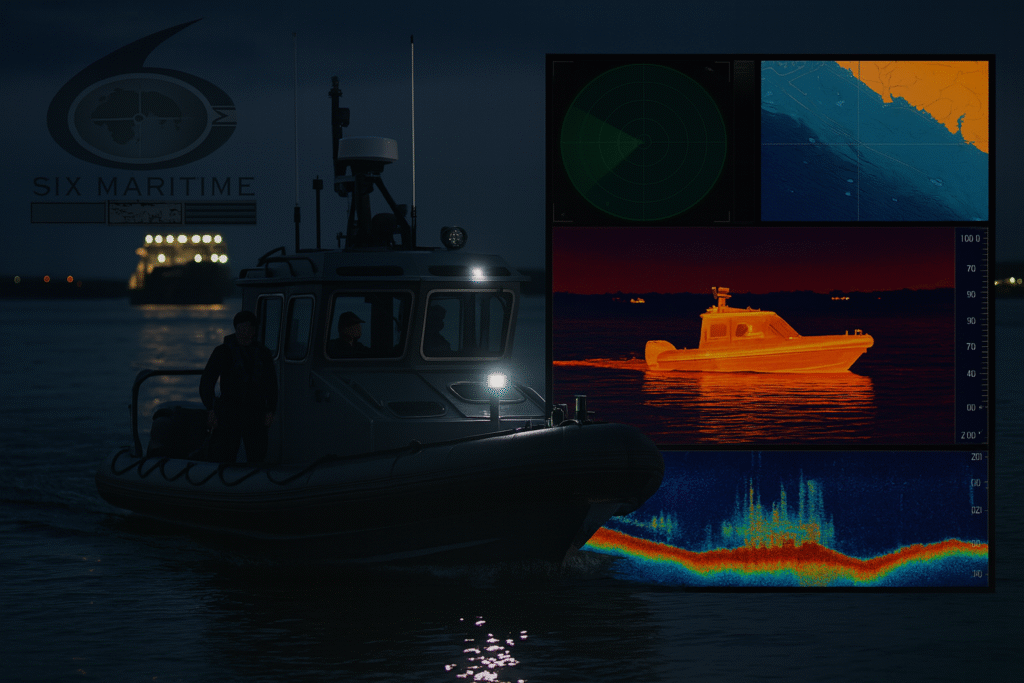
Naval innovation is accelerating at a pace not seen in decades. Between the Department of the Navy’s Science and Technology Board reshaping research investments and the Navy unveiling visions of modular, uncrewed surface attack craft, one thing is clear: the fleet of tomorrow will be vastly different from the fleet of today.
Yet amid all the excitement around new hull forms, autonomy, and artificial intelligence, a critical truth risks being overlooked: hardware alone does not secure harbors, deter adversaries, or reassure allies. Success in this new era requires integration, the careful pairing of human expertise with autonomous platforms, operationally proven sensors, and rigorous compliance with maritime security standards.
This is where companies like Six Maritime thrive.
The Technology Shift
Recent announcements highlight two major themes:
- Accelerated Naval Innovation – The Navy’s Science and Technology Board is restructuring priorities to speed experimentation and fielding, moving away from the slow acquisition cycles that have hampered past modernization. The emphasis is now on solutions that transition directly into fleet operations.
- Uncrewed Modular Surface Craft – The Navy has begun sketching out a vision for fleets of relatively small, modular, uncrewed attack craft. These systems are designed not to replace traditional warships, but to augment them, complicating an adversary’s calculus while providing flexible, lower-cost lethality.
Both trends signal a transformation: unmanned systems will no longer be niche demonstrations; they will be central components of fleet operations.
The Operational Gap
Technology, however advanced, does not automatically produce security outcomes.
Autonomous craft need operational frameworks:
- Who maintains them?
- Who integrates them with manned patrols, shore-based sensors, and port security forces?
- Who ensures they comply with NAVSEA 009-72 requirements when operating near naval vessels?
This “last tactical mile” is the gap between technological promise and operational reality. Without experienced operators and integrators, the Navy’s vision risks being left as concept briefs rather than deployed solutions.
Human + Machine = Maritime Security
Six Maritime’s positioning is built around closing that gap.
- Human Expertise – Our crews have logged hundreds of thousands of hours protecting naval vessels, conducting security patrols, and training DoD and commercial clients. This experience provides judgment, adaptability, and trust.
- Autonomous Platforms – We partner with USV developers to test, evaluate, and operationalize their craft. From side-scan sonar integration for swimmer detection to autonomous RAM patrols at naval shipyards, we bring technical concepts into real-world execution.
- Compliance & Trust – Every operation we run adheres to NAVSEA 009-72, MTSA, and ISO 9001:2015 standards. Clients know their assets are secure, and their compliance obligations are met.
This fusion of people, platforms, and process is the only way to translate innovation into security outcomes.
Why This Matters Now
The global maritime environment is becoming more contested. Peer competitors are investing in swarming drones, gray-zone maritime militias, and disruptive technologies. Ports and shipyards remain tempting soft targets.
At the same time, the U.S. defense ecosystem is accelerating funding pipelines, loosening acquisition bottlenecks, and demanding rapid fielding of prototypes. That means companies capable of deploying integrated solutions, not just hardware vendors, will capture the emerging opportunities.
Six Maritime is already positioned in this space. Our POAM priorities include:
- Expanding partnerships with autonomous/AI developers.
- Producing white papers and case studies on USV integration in port security.
- Demonstrating human-AI teaming at live Navy and port events.
- Building customer trust by combining innovative solutions with continuity of service.
From Vision to Execution
Picture a naval base at night. Traditional security patrols still operate, spotlights cutting across dark water, experienced coxswains alert at the helm. Alongside them, a modular USV maintains a persistent patrol route, feeding real-time thermal and radar imagery back to command. Anomalies are flagged instantly, allowing the human team to focus on decisive action rather than routine scanning.
This is no longer a concept for the future, it is an operational reality already being demonstrated.
Why Six Maritime?
Many firms are chasing the unmanned wave. Some are hardware builders. Some are contractors submitting exploratory proposals. Few can claim what Six Maritime delivers:
- Proven Operations – Past performance with major shipyards and Navy contracts.
- Innovation Credibility – Recognized at MARSEC, SOF Week, and BlueTech for our integration work.
- Strategic Vision – A POAM-driven roadmap aligned with the Navy’s own modernization trajectory.
- Agility – As a Service-Disabled Veteran-Owned Small Business, we move faster than primes while maintaining compliance rigor.
We are not theorizing about the future of maritime security. We are operating it, today.
From Vision to Reality
The Navy’s vision of modular uncrewed craft and accelerated innovation is inspiring. But the path to making it real runs through experienced, agile operators who know how to integrate technology without sacrificing compliance, safety, or mission success.
That is Six Maritime’s role: the gold standard in human-AI maritime security integration.
We protect today’s fleet while shaping tomorrow’s.
